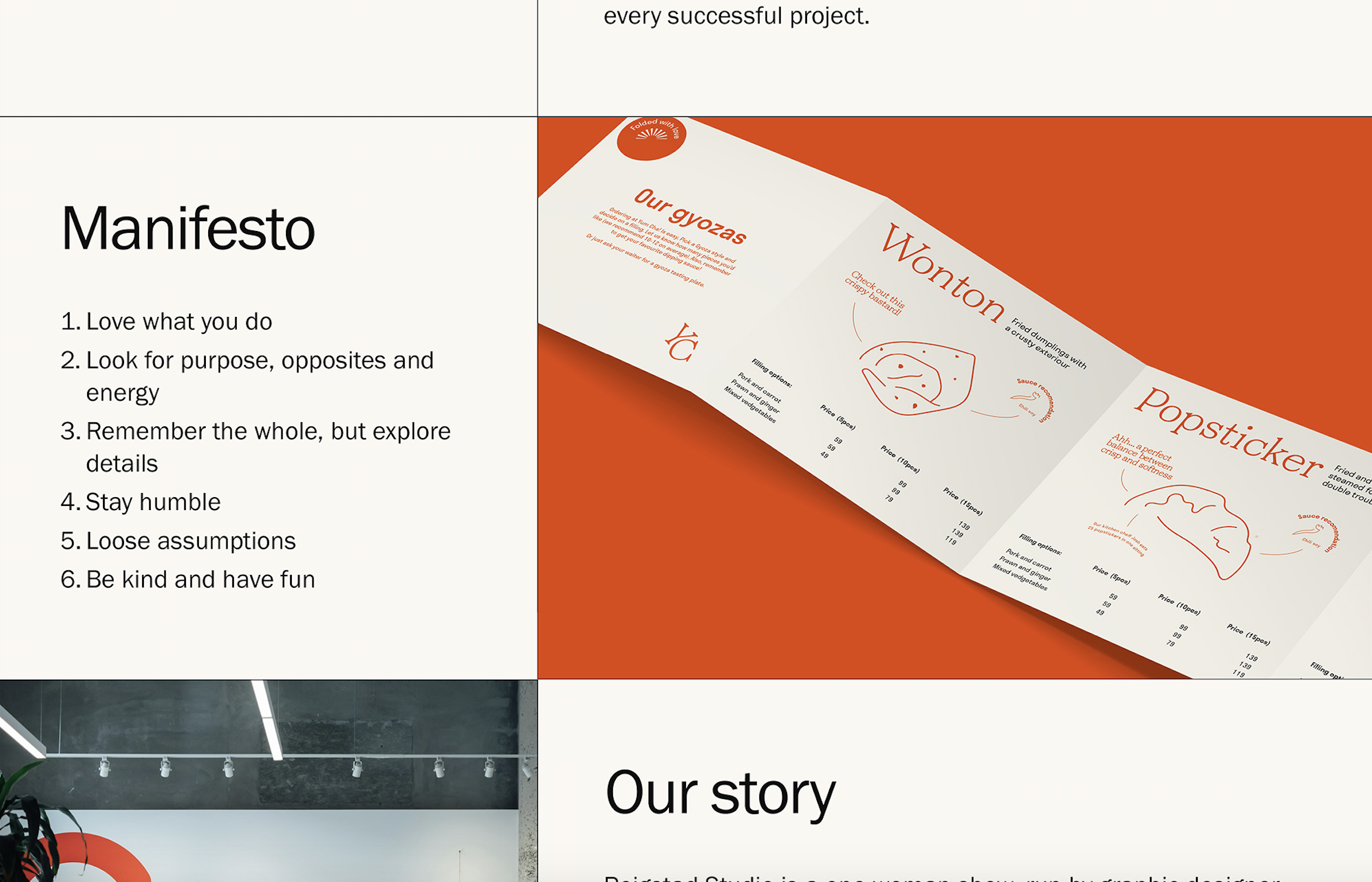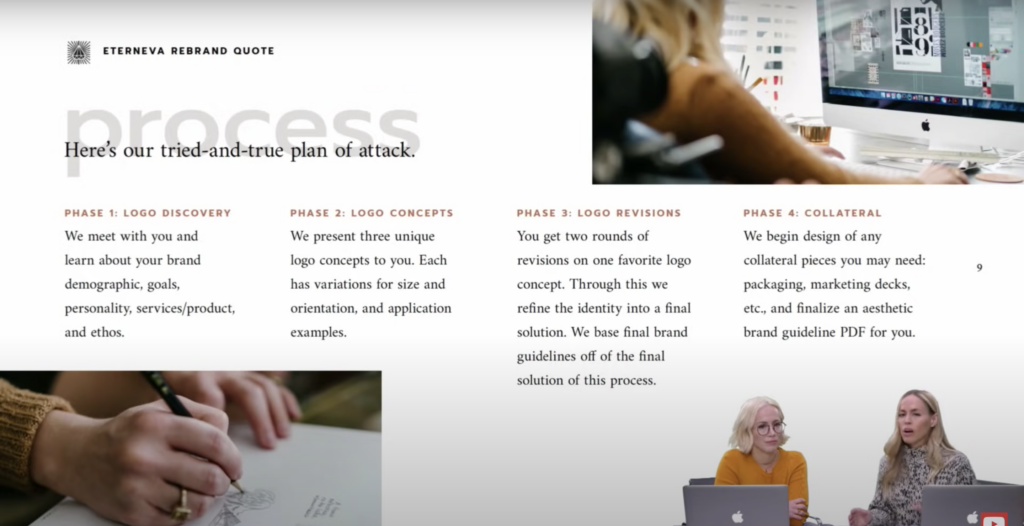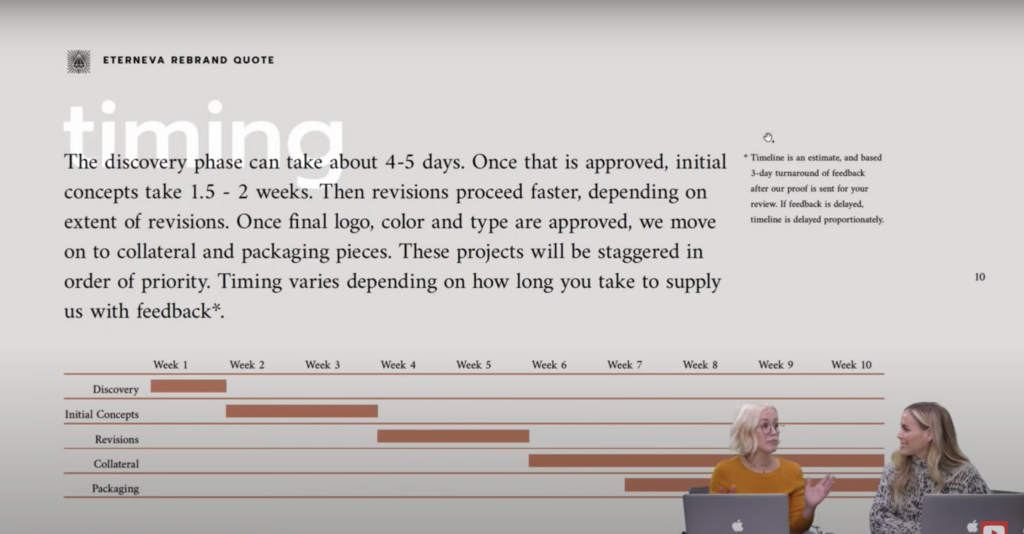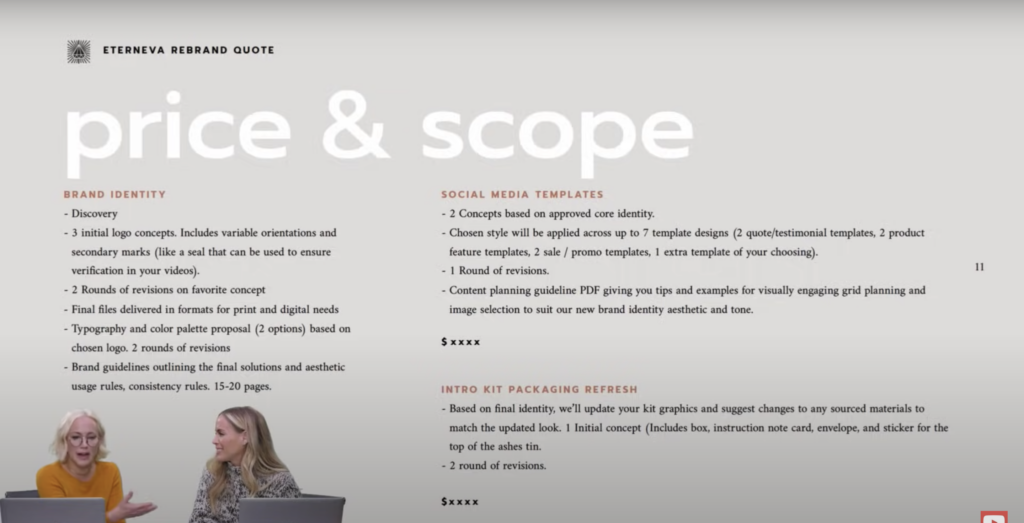Lecture notes
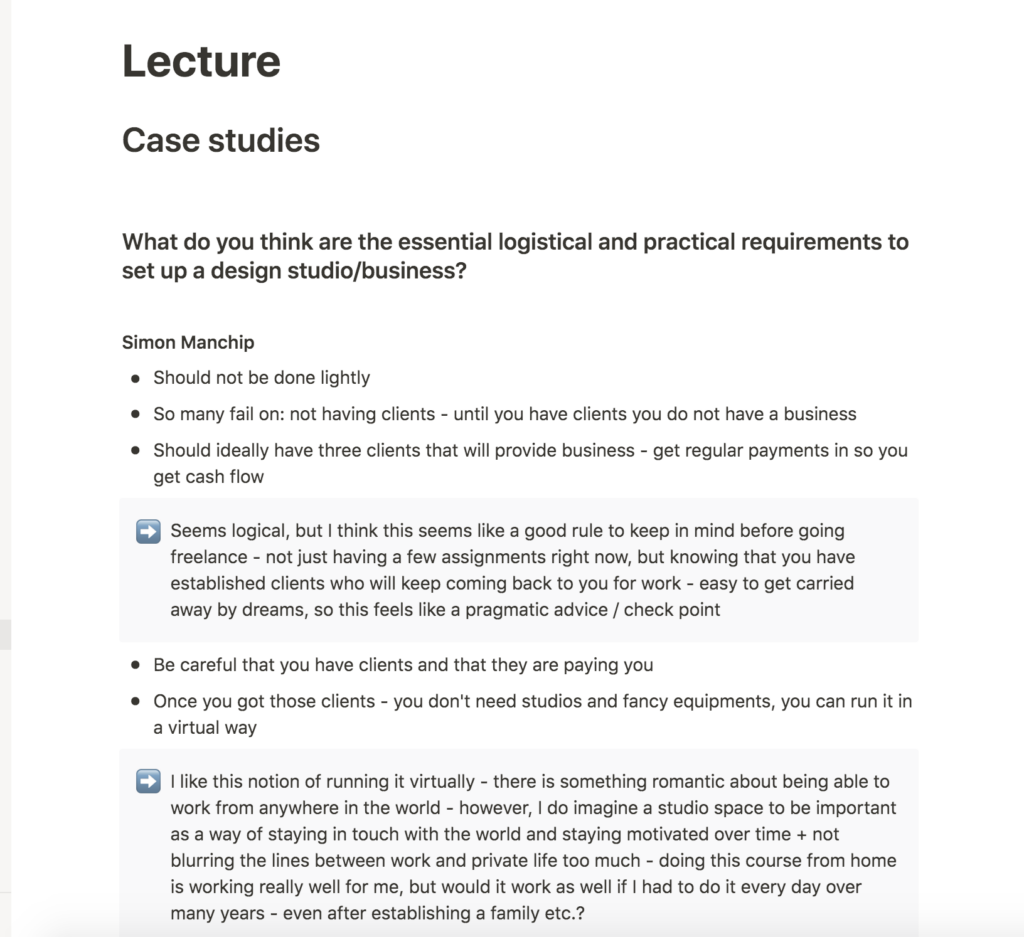
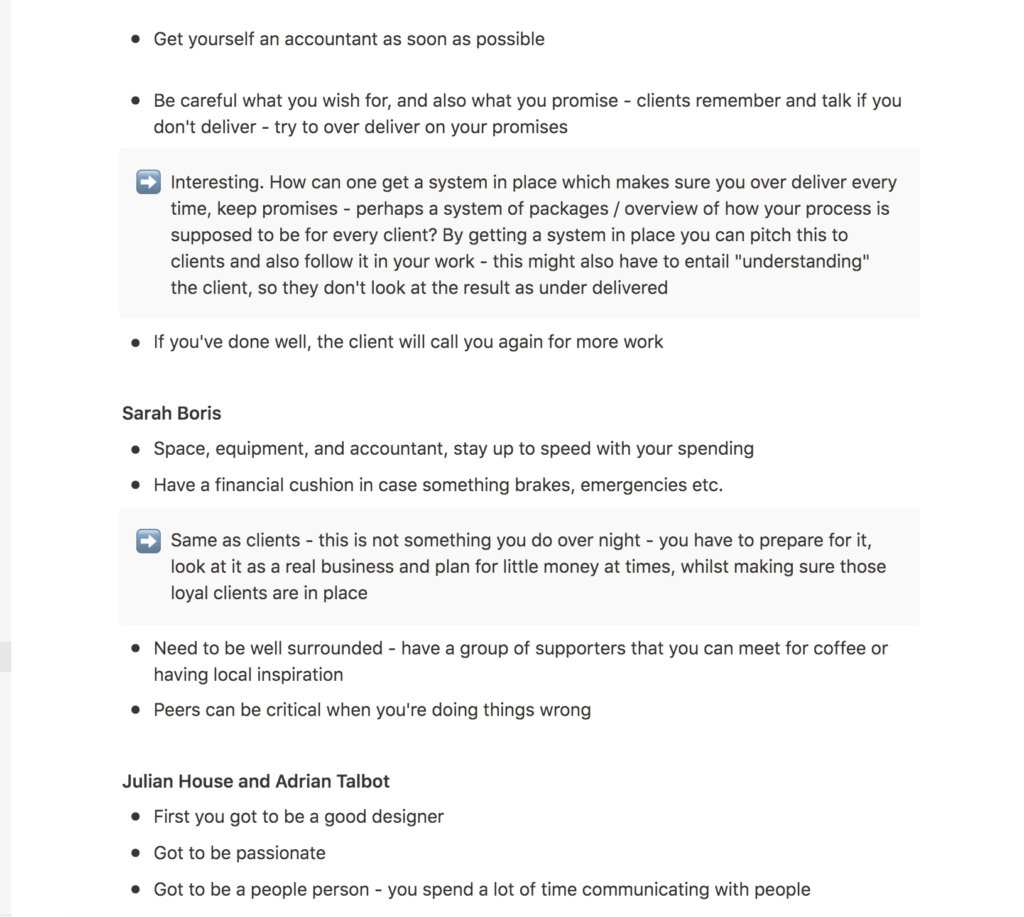
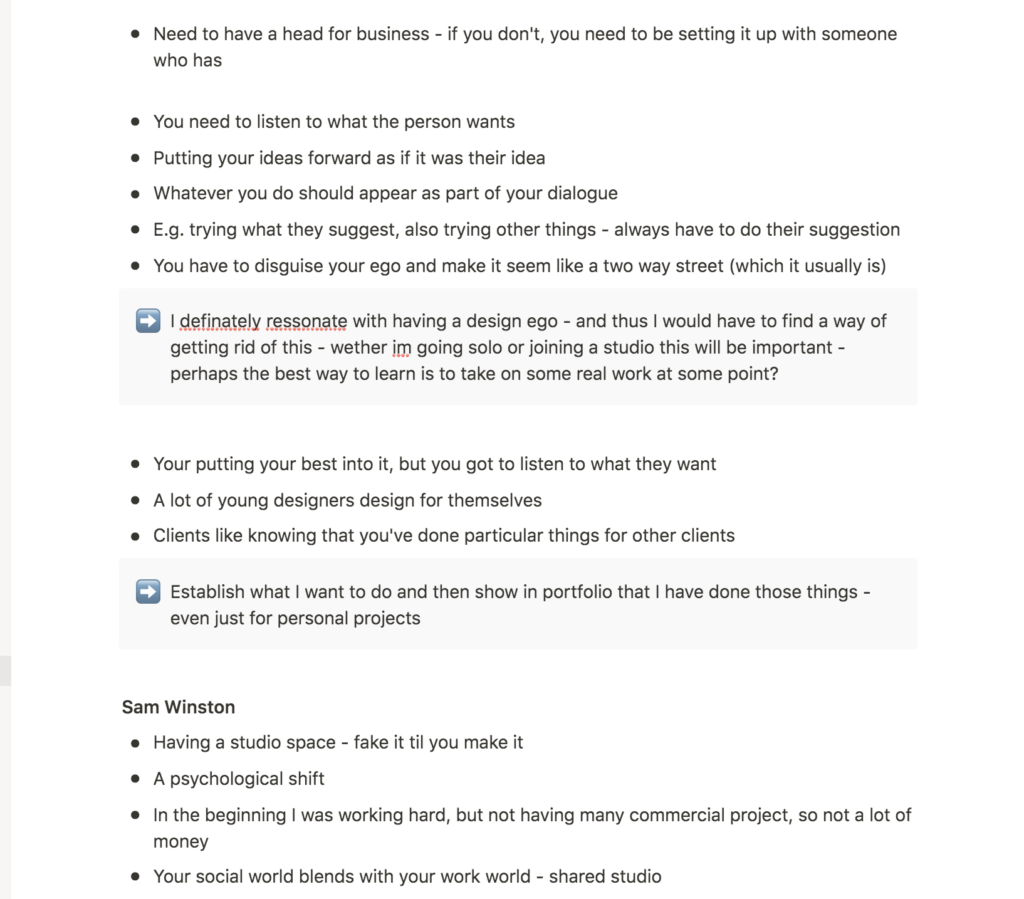
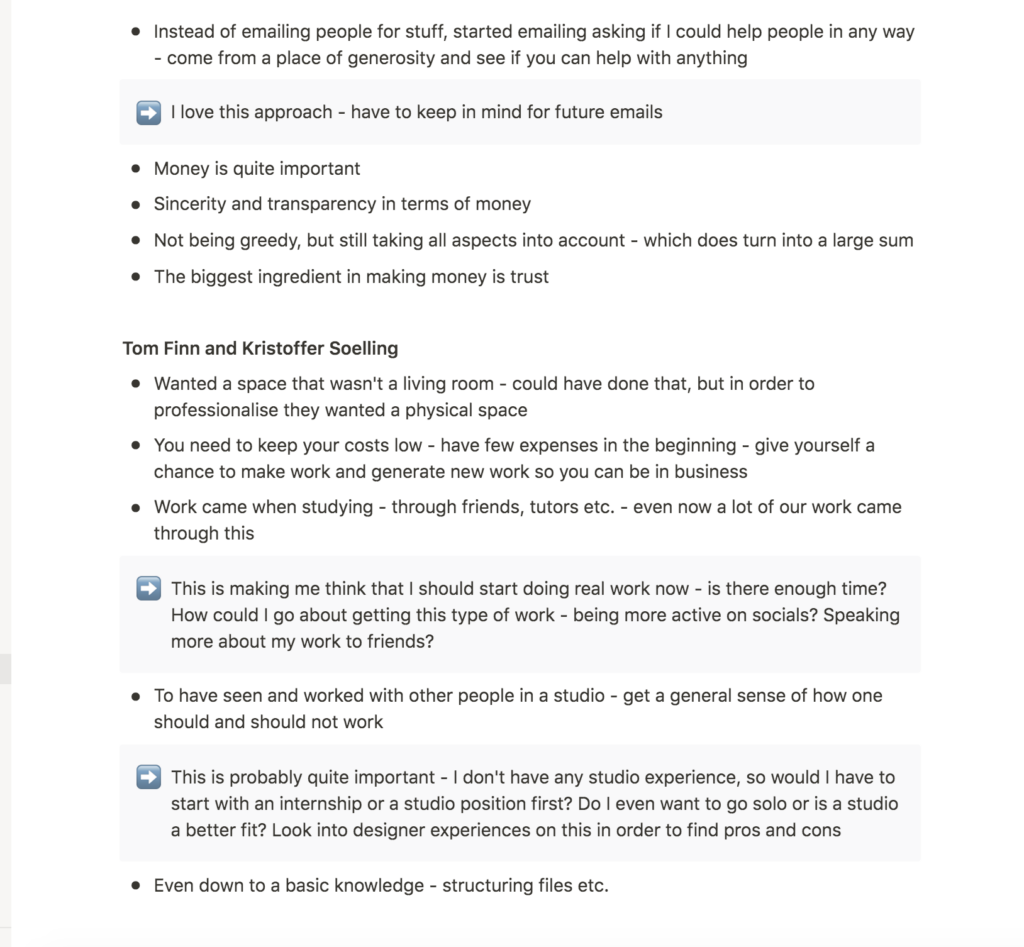
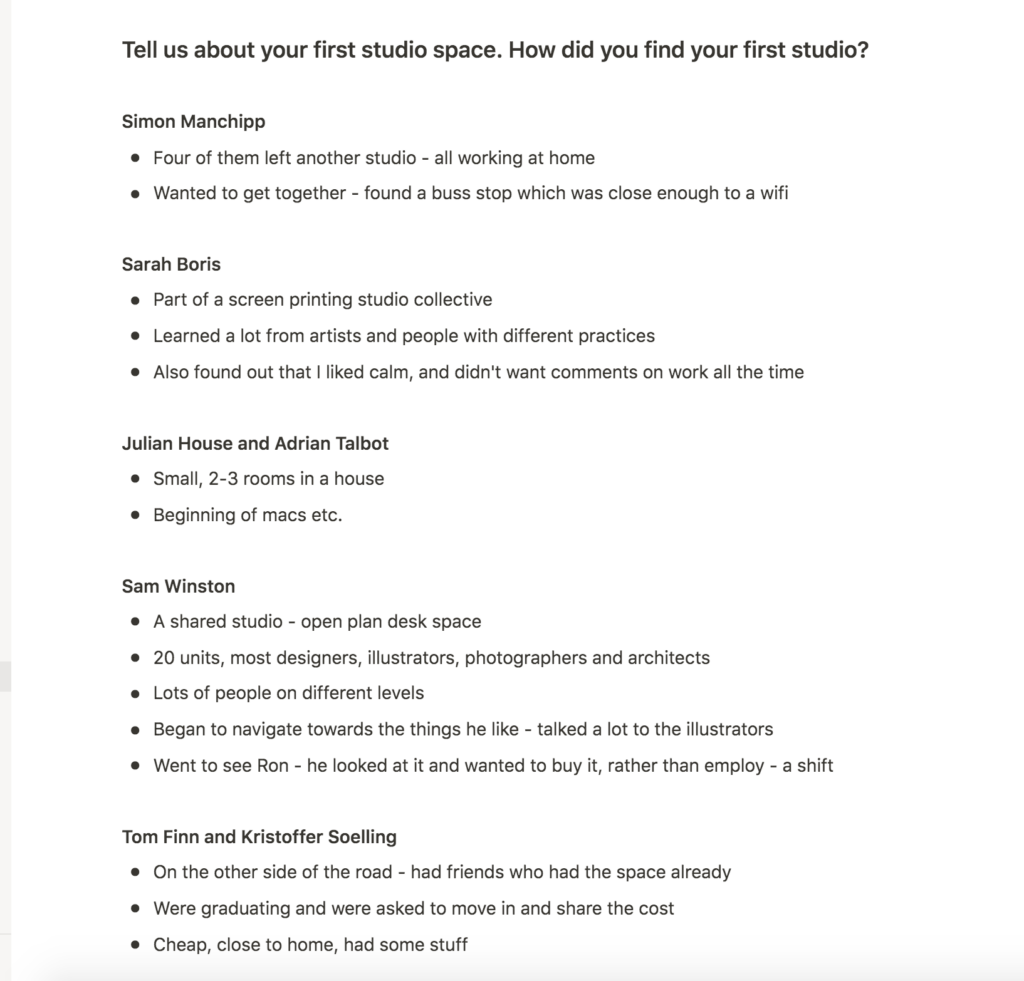
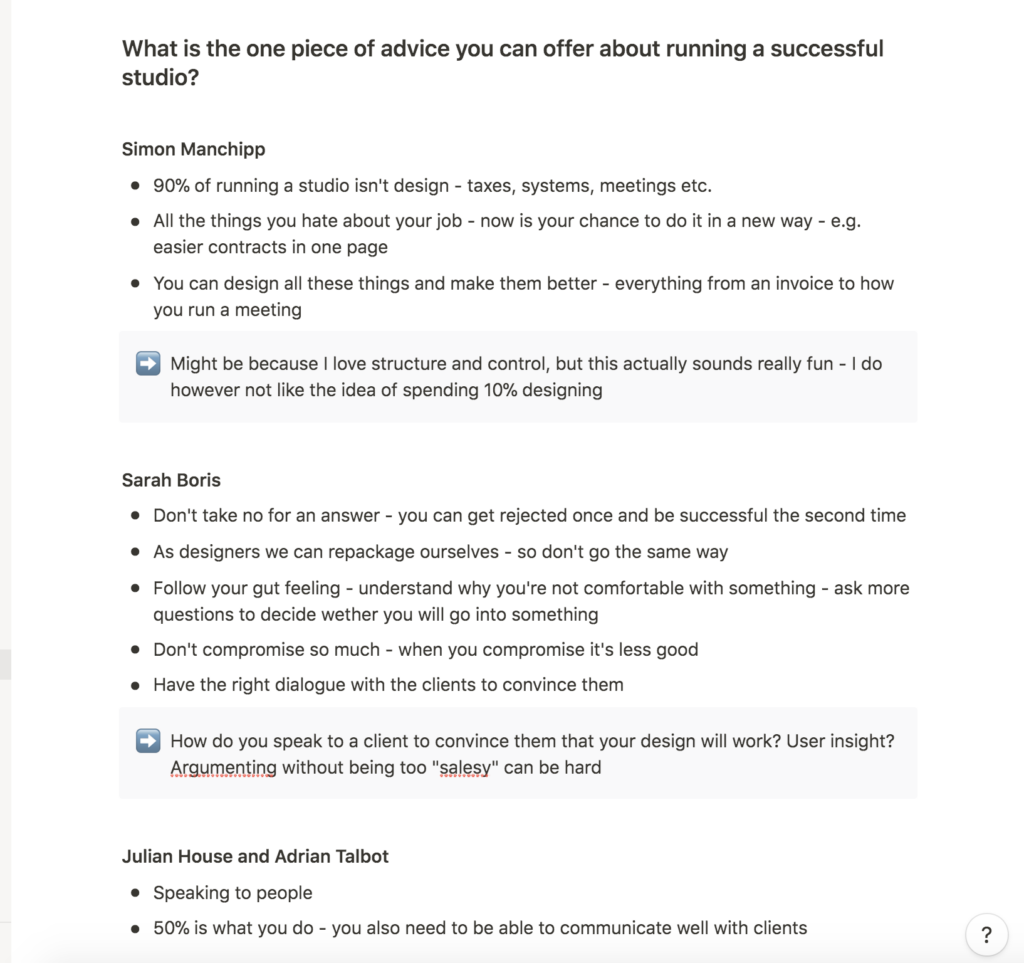
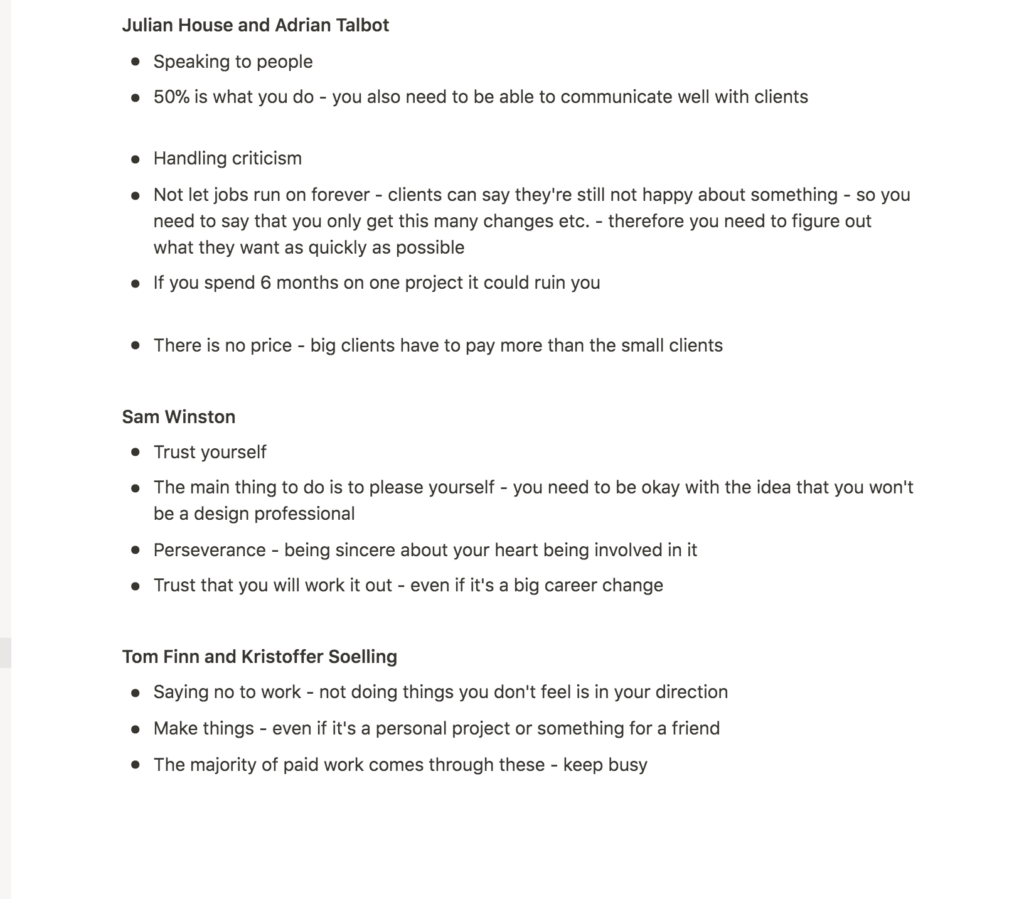
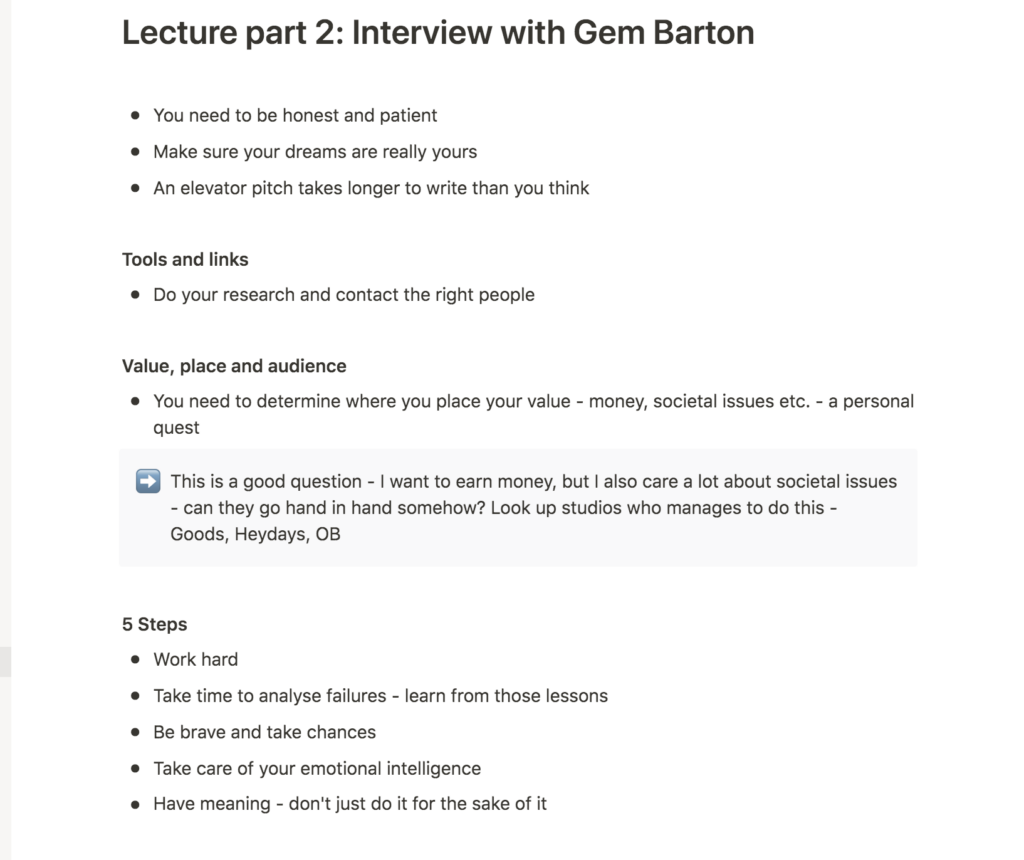
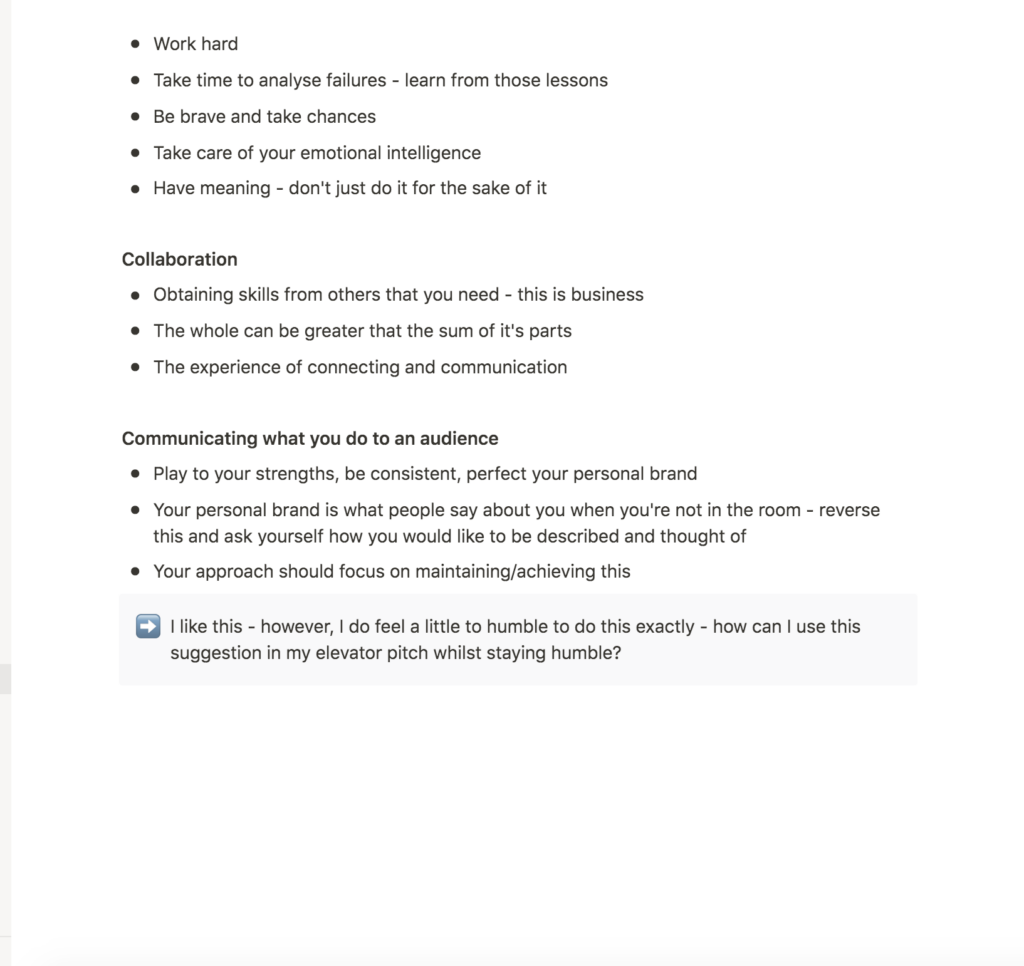
Lecture reflections
Practitioner Case Studies
Making sense financially
This week’s case studies were great as they were inspiring, but also provided realistic insights on starting your own design studio. Manchipp’s advice about having three clients before starting a studio was logic, but useful (Simon Manchipp et al., 2021). Just because you have one project right now, it doesn’t necessarily mean that you’ll have work in a few months time. As someone who tend to get carried away by dreams, this feels like a pragmatic advice that I will keep in mind for if and when I decide to branch out on my own.
Could one create a system to ensure client satisfaction?
I also liked Manchipp’s advice on over delivering to clients and keeping your promises (Simon Manchipp et al., 2021). This made me wonder how one might get a system in place, which ensures satisfaction. Could one establish a design process which 1: is communicated to the client so they know what to expect in terms of time, efforts and delivery, and 2; helps you identify what the client is actually looking for, so that your design is in line (or above) with their expectations. These reflections also answers to House and Talbot’s discussions on disguising your ego and making your design appear as the result of a dialogue (Simon Manchipp et al., 2021).
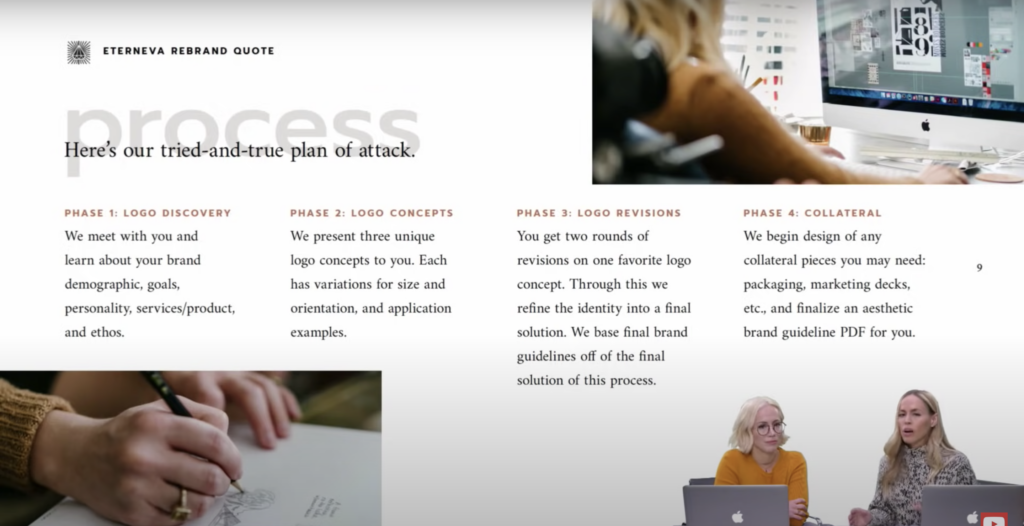
Fig. 1: Hoodzpah 2019. Graphic Design Tutorial with Hoodzpah Design (1/3) | Adobe Creative Cloud.
Although it might seem obvious, Manchipp’s discussions on getting to design everything from meetings to contracts (Simon Manchipp et al., 2021), made me realise that a design studio should pay as much attention to user experience as any other business. As designers we are lucky enough to have experience with branding and problem solving, so why not make the design studio experience as perfect as those projects we work on every day? I think this notion of designing a customer experience for a design studio could be an interesting topic to explore in the weeks to come.
Interview with Gem Barton
Designing for the good or designing for money?
In his interview, Barton presented an interesting dilemma on determining where one places one’s values (Gem Barton, 2021). I would personally love to work with branding, and this, of course, is centred around advertising, and thus making money. However, I do have a couple of societal issues that I care about, and that I would like to make part of my work. So, is it possible to earn money, whilst staying true to ones values? It could be interesting to look into how design studios handle this balance.
How to describe oneself
Further, Barton provided good advice on describing oneself to an audience, in that he thought one should describe oneself as how one would like others to talk about you when you’re not in in the room (Gem Barton, 2021). I will keep this in mind for the workshop challenge this week, whilst also attempting to stay humble in my description.
Resource notes
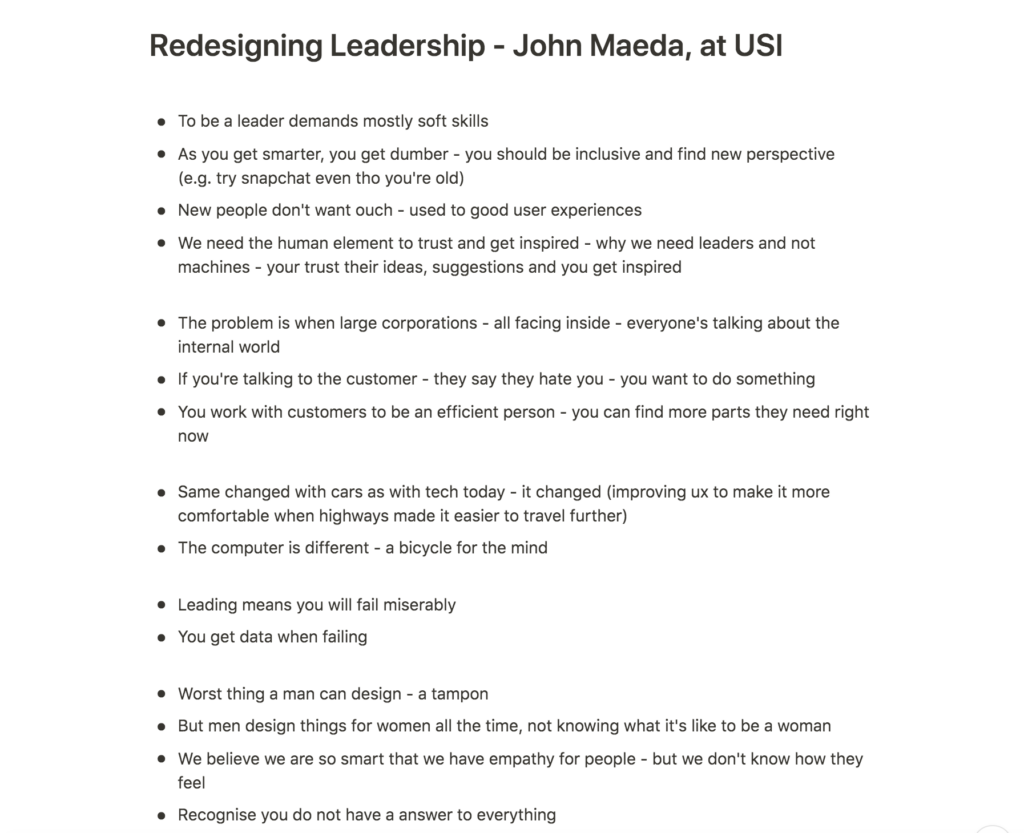
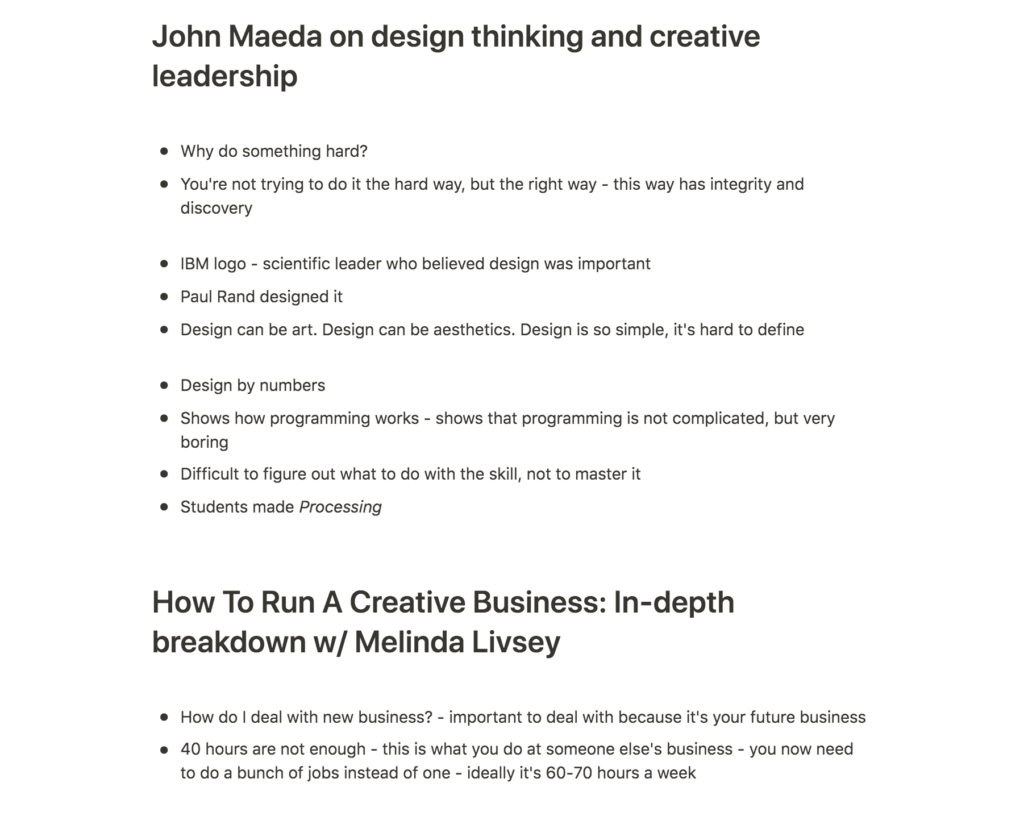

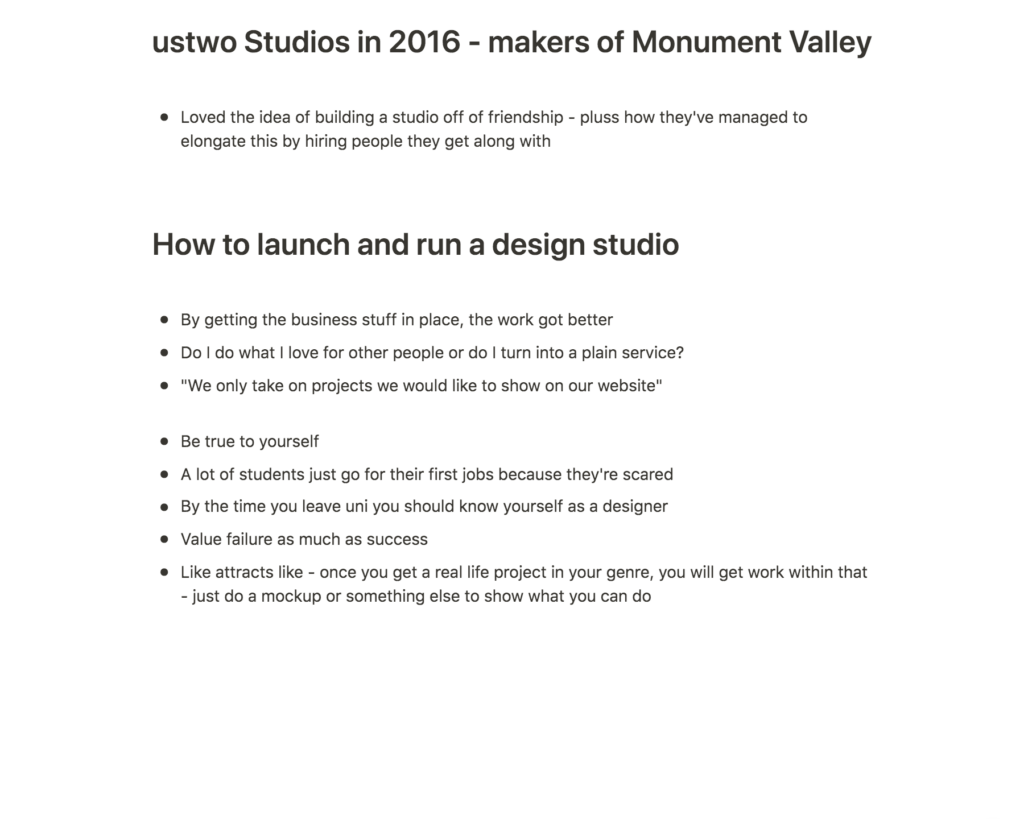
Resource reflections
How To Run A Creative Business w/ Melinda Livsey
Getting effective
I really enjoyed Do and Livsey’s discussions on running a creative business. They were straight to the problem and the advice felt clear enough to go ahead with. Even though Do’s idea of working hours seemed a bit extreme to me (in Norway most people work 7,5 hours a day, so this might also be a cultural difference), his suggestions on putting in two more hours of work a day, as well as his advice on getting more productive were great (The Futur, 2017).
Managing clients and their budget expectations
Further, the video opened my eyes to the importance of business when running a studio. Like Melinda, I wouldn’t have thought about bringing up the budget during the first client call, but after hearing Do talk about it, it seems logical (The Futur, 2017). By doing this one can save both one’s own and the client’s time. Further, Do’s advice on presenting one’s work was useful – by making it seem luxurious, you will attract clients with more money (The Futur, 2017). As discussed in my lecture reflections, this video also made me think about the importance of customer and user experience for a design studio, even when that studio consists of one person only.
How to launch and run a design studio
Like attracts like
Moving on from Do’s advice on case study presentations, the Like attracts like advice from the Computer Arts video were interesting (Computer Arts, 2016). At the moment, my portfolio consists of a variety of projects, and if I want to work with branding only, this means I might have to do more branding work. This seems obvious, but was a good reminder for me when it comes to my planning future uni projects. Moving on from this, I also think it could be good to reflect upon which types of business segments I would be interesting in working with in the future.
Further research
Hoodzpah: ensuring customer service through dialogue
Inspired by this week’s lecture case studies, I was intrigued to look into how other designers work with customer service and user experience, in order to make sure that they are not under delivering in their work. In an Adobe Live session, design studio Hoodzpah goes through one of their client quote documents, and I think this seems like a great way of managing client expectations, whilst also ensuring that their design work is in line with the client’s need.
The presentation presents Hoodzpah as a design studio (some of their previous work, their ethos, their team, etc.), but also their design process, a detailed time line and detailed lists of delivery content (Hoodzpah, 2019). As a client, this would make me feel taken care of, and I wouldn’t be worried if I didn’t hear from the studio within the first couple of days, as I would already know what they would be up to.
In order to ensure even better user experience, I think a design studio would be clever to work closely with clients in order to gain insight on potential issues with their individual experiences.
How do established design studios balance societal values and money in their elevator pitches?
Considering the fact that I would like to earn money, whilst also using my interest for societal issues in my work, I decided to look at how the studios Goods and Olssøn Barbieri talks about themselves. They are both Norwegian branding and packaging studios, who brands themselves as environmentally conscious.
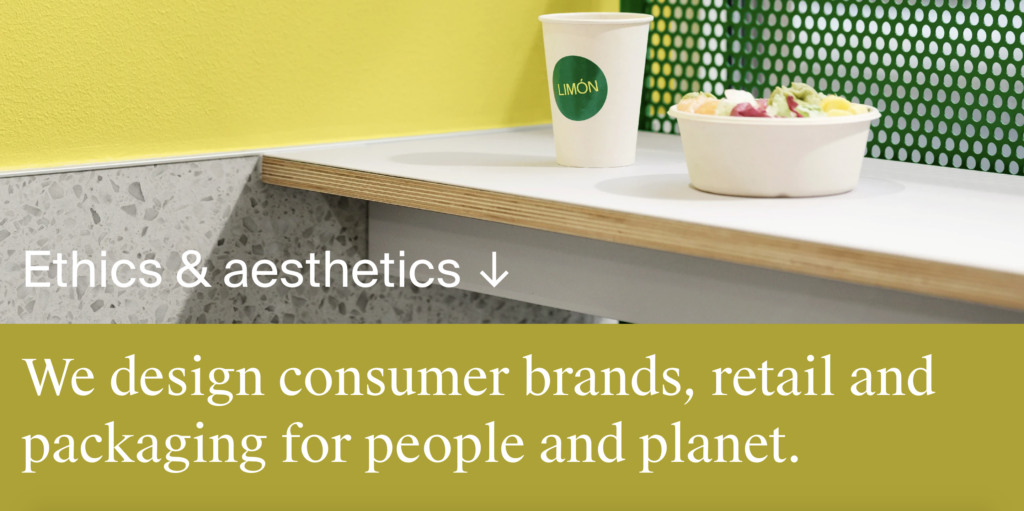
Goods describes themselves like this: “We design consumer brands, retail and packaging for people and planet” (Goods, Ca. 2018-2021). In only one sentenced they have managed to describe their balance between consumerism (money) and the planet (societal issue). I like that they are not hiding the fact that they are money-driven, even if they are branding themselves as ethical – they are being transparent with their aim, which establishes trust.
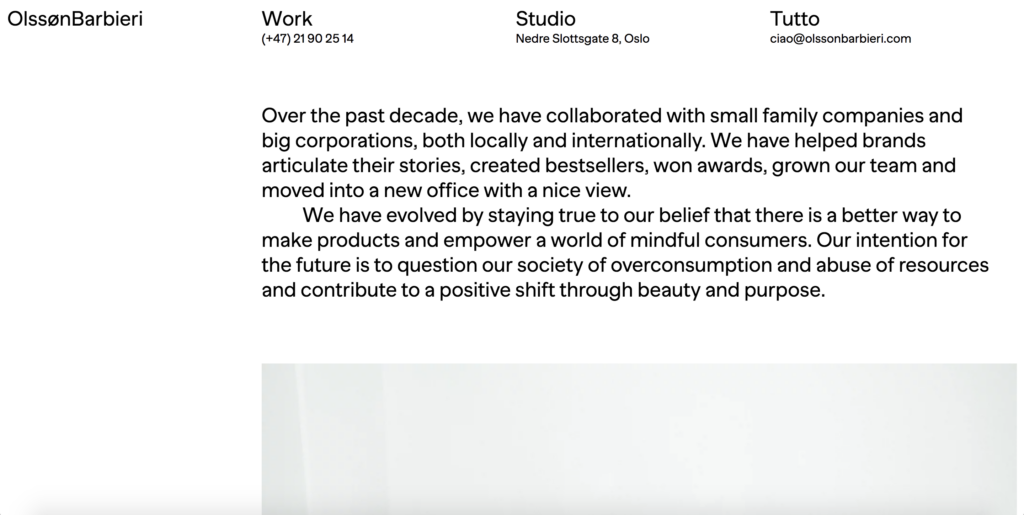
OlssønBarbieri does beautiful packaging work, and on their website they in a similar way as Goods, talk about both packaging as a product for corporations, but they also talk about their intentions for the future in regards to overconsumption and abuse of resources (OlssønBarbieri, Ca. 2018-2021). Further, they also discuss their responsibility as designers (OlssønBarbieri, Ca. 2018-2021). OB’s way of almost presenting their sustainable conscious as innovation seem like a clever way of appealing to clients, as I imagine most clients wanting to be at the forefront of packaging.
I would be curious to know wether or not these studios would turn down a client who weren’t interested in focusing on environmental issues – would they stay true to their identity and turn it down, or would they do it for the money and just not put it on their website? This seems like an important question to ask oneself before starting a studio, in order to establish one’s own values and what type of work one would be willing to take on.
Workshop challenge
Before starting the workshop challenge this week, I had a quick reflection on what type of business I wanted to “create”. In the future I would like to be part of a medium or large sized studio. However, I don’t think I’d like to start a large studio on my own, as I imagine that meaning not getting to design a lot, but rather focusing on running a studio. The idea of working as a freelance designer however, is more tempting, as I like the idea of being in control of my time, structure and personal values being reflected in my work. The material this week also opened my eyes to the possibility of actually doing this, so I’ve decided to focus on a speculative freelance position for the task, as I’m curious to look into what this decision would entail.
Establishing my ethos, positioning and audience
In order to understand what my freelance practice would be, I decided to reflect upon what type of work I enjoy, my personal values and what sort of position I imagine my practice having. I used mind maps as a reflection method as I find this helpful for sorting a bunch of ideas and insights.

What do I want to work with?
At this point in time, I see myself working with branding. My favourite branding works are usually visual identities consisting of design systems, rather than the logo only, and I would definitely like this to be my focus. I enjoy a thorough design process, and my goal when designing is to come up with a thought through and holistic concept. I don’t want to create similar work to every other branding studio, but I do consider myself a modern designer who’s work is in line with the times we are living in. Since starting this course my interest for typography has grown, and I would like to make this part of my work, perhaps through type oriented work.
Values
As a person I am conscious about living ethically on several levels. Inclusivity and sustainability is important to me, and these are values I would like to make part of my work. Since branding is my preferred design area, including sustainability in my work could be challenging (yet interesting), as consumerism is not typically associated with sustainability. Thus, innovation is another important value. Lastly, I love experimenting and creativity is another important value to me.
On the practical side, I like control and structure, and it would be important for me to communicate control to clients in order to seem trust worthy and safe. I do pay attention to what others think of me, and so the customer experience, from beginning to end, would have to be on point. This doesn’t mean that I wouldn’t want to create innovative and exciting work, it just means that I would need a system in place which secures satisfaction in both ends.
Who is my audience?
I don’t really see myself working within one segment only (like the cultural sector), since all business segments have clients looking for visual identities. Rather than targeting a specific sector, I am interested in targeting specific people, who share the core values of my practice. Thus, my audience would consist of businesses concerned with aesthetics, sustainability, innovation / forward thinking and inclusivity (yet I don’t think hey would need all four). Since I would be a solo entrepreneur, I imagine small and medium businesses being a good fit. However, you do have small studios like Lowrie, who designed the whole Sundance Festival. Due to technology I also think I’d like to offer international services, yet I’d probably be clever to start off locally in order to build a name and client base.
Studio philosophies
As advised in the workshop challenge video, I went on to have a look at design studios’ about pages. I had a look at some of the studios from the geo tagging workshop from the Creative Practice module, but I also visited some new ones. In order to understand each philosophy, I’ve analysed it through the workshop challenge questions (what, how and why).
Bleed
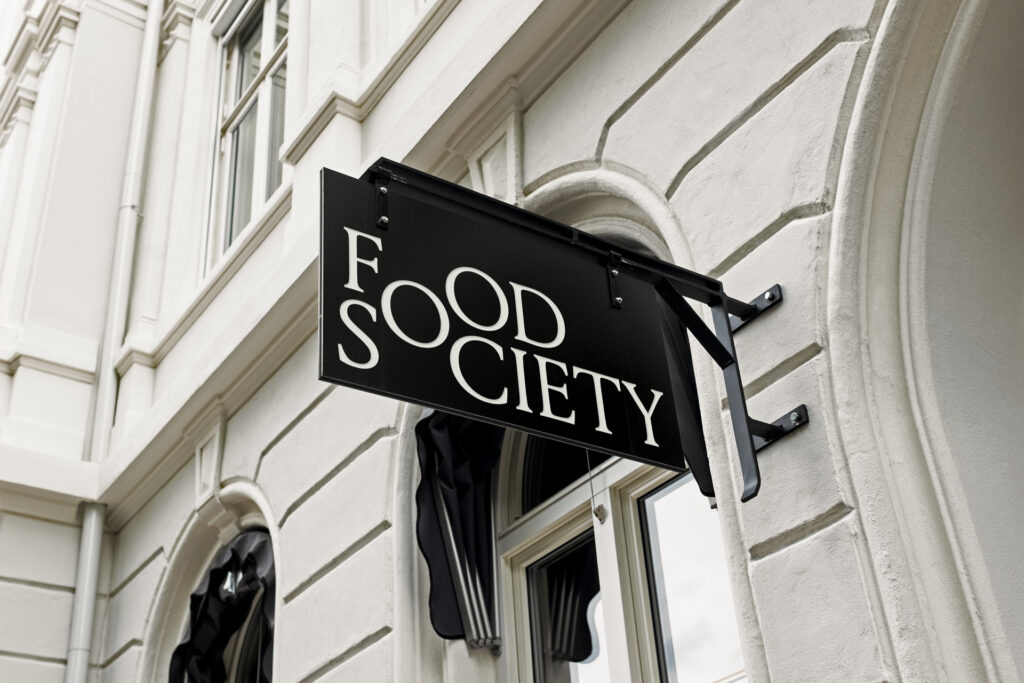
BLEED blurs design, technology, art & strategy to create compelling visual identities, services and experiences for our clients.
(Bleed, Ca. 2018-2021)
- What is the idea?
Visual identities, services and experiences - How does it work?
Through blurring design, technology, art and strategy – a interdisciplinary approach revolved around creativity on different levels - Why does it work?
The fact that the identities are compelling, gives the impression that they work by being persuasive of users. I personally read this word as there being a story or visual concept in place which convinces the users of the identity/service/experience. The for our clients also makes me think that their work revolves around the business, and as a client I would like to know that the work is first and foremost suitable for my business.
I like how short the pitch is and that it’s not using too many buzz words, as I find that long paragraphs with big words can be more confusing than informative.
Heydays
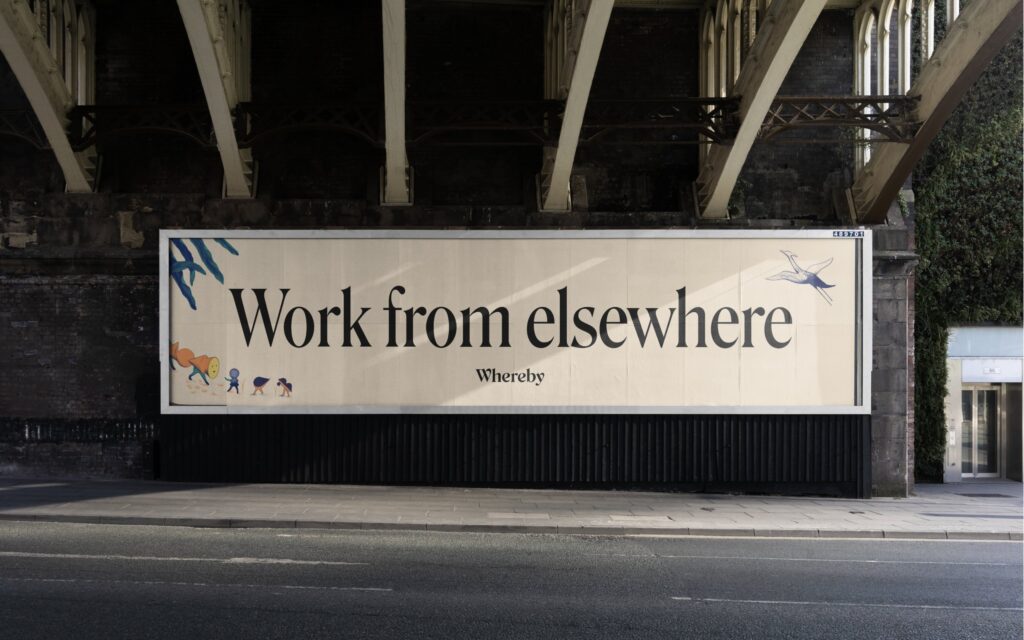
Turning great ideas into unique experiences
(Heydays, Ca. 2018-2021)
Heydays is a design team tailored for ambitious companies in rapid growth or major change. We’re here for those who challenge conventions and push for better. Through brand strategy, identity development, and product design, we help our clients shape what’s next. (…)
- What is the idea?
Turning good ideas into unique experiences. In other words, they help businesses communicate their idea/concept as unique and something you experience, rather than something you just look at / read about etc. - How does it work?
Through the use of brand strategy, identity development, and product design. In their approach they challenge conventions, which is how their experiences become unique. - Why does it work?
Since they are tailored for ambitious companies in growth or change, the challenging of conventions is suitable as it “helps them shape what’s next”. An ambitious company has ambitions for the future, and being concerned about what’s next is thus effectively their goal.
Lowrie

Lowrie is a London-based design studio with an international set of clients and projects. We use our passion for typography as the basis to challenge each brief, regardless of scale or application.
We are driven by those we work with: when there is chemistry, trust and decisiveness, very good things happen.
(Studio Lowrie, Ca. 2016-2021)
- What is the idea?
Topography led design, driven by the businesses they work with. The regardless of scale and application indicates that they are not focused on one type of design, but that they are open to different briefs. - How does it work?
They use the client relationship as a foundation for their work, and typography also seems to play a large part. - Why does it work?
The way I read this, human relationships and feelings are a big part of why their work works. They mention their passion for typography, but also the client chemistry, trust and decisiveness. Thus, one might say that it works due to their way of being and communicating with people.
WolffOlins
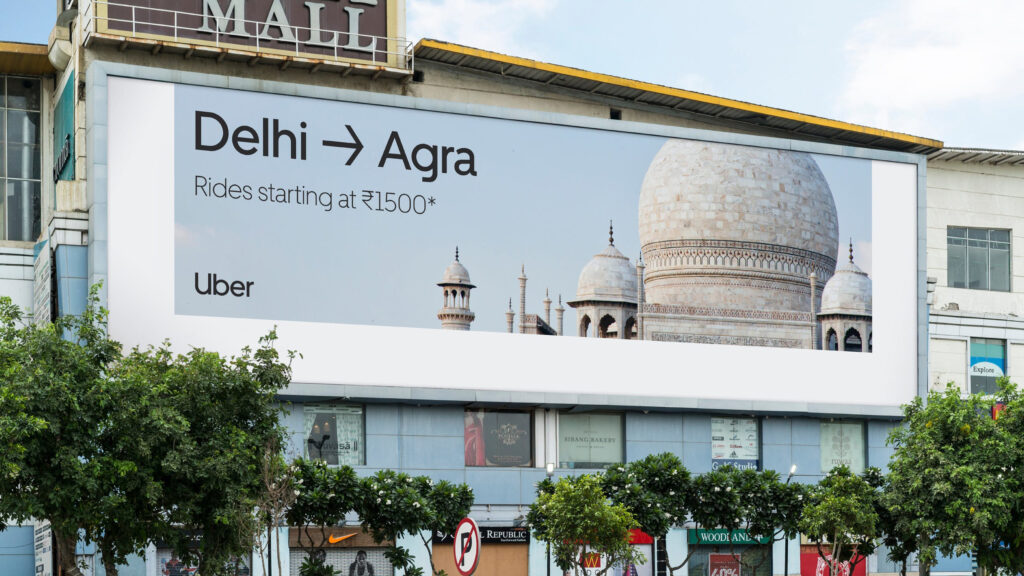
We help create transformative brands that move businesses, people and the world forward.
(WolffOlins, Ca. 2018-2021)
- What is the idea?
Brands that moves businesses, people and the world forward. In other words, brands that engage people, and that are innovative. - How does it work?
They create transformative brands. Perhaps the brands transform people’s minds? Or maybe they transform society somehow? This seems broad, probably due to the size of the studio and it’s dominance. - Why does it work?
The reason for the being of a brand is effectively to transform something – wether it’s to transform a consumer’s mind into wanting to buy a product, or it’s to transform a societal issue. Transforming is a very big and word, which sits at the core of a brands existence. Thus, one might assume that the studio’s work is much bigger than a single logo.
&Walsh
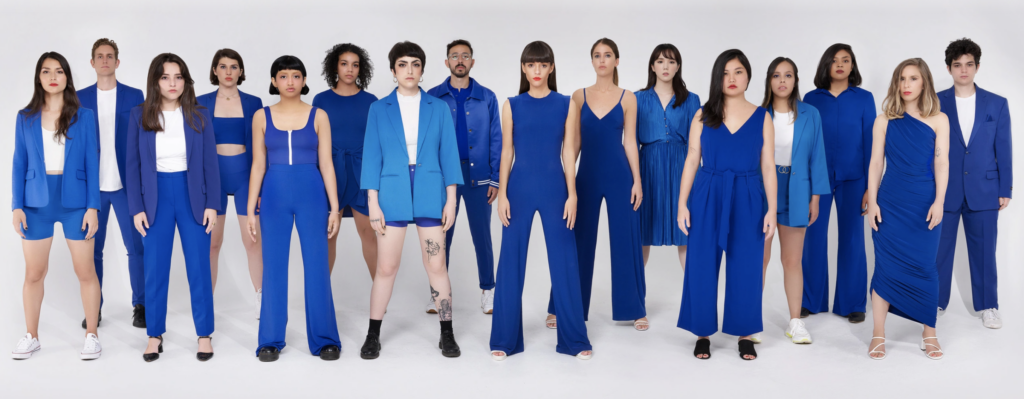
We are a creative agency in NYC specializing in branding & advertising. We work with clients starting from the initial brand strategy phase to the design, art direction and final production of a project. We believe in creating beautiful, emotion-driven work that functions for our client’s goals and resonates with their audiences.
(&Walsh, Ca. 2018-2021)
- What is the idea?
Beautiful and emotion-driven branding and advertising, in line with the client’s goal and audiences. - How does it work?
They work with brands from the strategy phase, to the final design and production of a project. - Why does it work?
It works because their work functions for the client’s goal and it is in line with the client’s audience. Thus, it takes the client’s business into account, without loosing track of the end user, which is the main aspect one needs to cater to in order to meet the client’s goals.
The &Walsh identity also demonstrates their ability to make original and cohesive work as it’s very unique in the area of design studio identities. Their focus on presenting the studio team suits their human values, and it also puts a face on who you’ll be working with if choosing them. However, since the identity is unique, they might be lossing certain customers as well (although I imagine them being happy to take this risk as they might not want clients they don’t resonate with).
Stefan Sagmeister
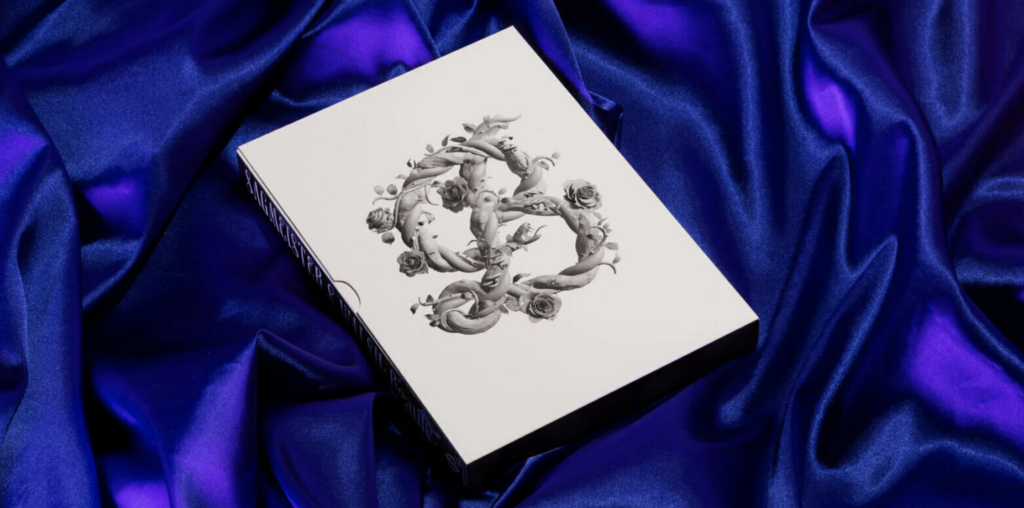
Lastly, I enjoyed Sagmeister’s information page, which consists of a bunch of Q&As within several categories. Having visited a bunch of similar-ish design studio elevator pitches, the unique format made me stop and explore. Is there perhaps a way of writing/designing my own elevator pitch in a way that is easy to find and read, but that is presented in a unique format?
Lean Canvas
Through one of the links provided in part two of this week’s lecture, I discovered a document explaining how to make a Lean Canvas by Ash Maurya. In order to reflect on what my future freelance practice might look like (and to write my elevator pitch), I decided to fill one out, based on my current thoughts (I purposefully left out cost structure and revenue streams as I saw that we would be looking at this in one of the following weeks):
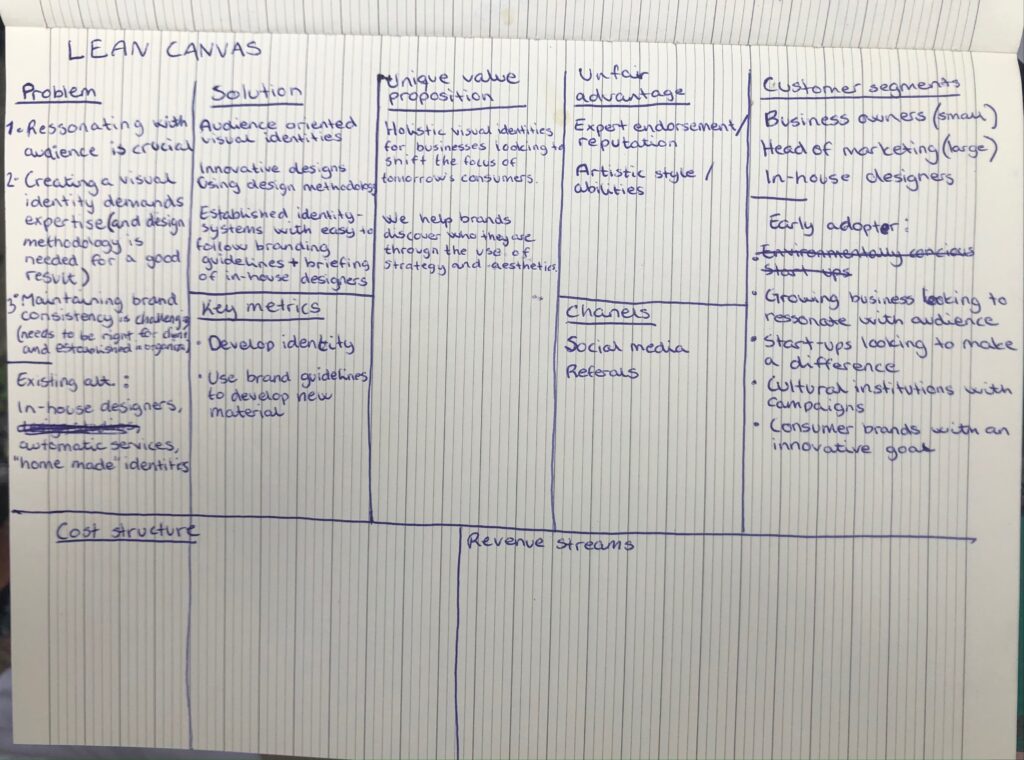
This was very helpful as it got me thinking about customer segments and target audience. It also helped me narrow down what issues my potential clients are facing, and what services I could provide to help them solve these issues.
In the box for unique value proposition, I started experimenting with what my final elevator pitch could look like.
What separates my practice from other designers?
The lean canvas (and a question made by Harriet on the ideas wall) made me wonder how my design practice will stand out within the design industry – what could my USP look like? The fact that I’m specialising in sustainable solutions would help me stand out from the crowd, although there are several studios out there focusing on this today.
Another way of looking at the sustainable approach, is to target an environmentally focused audience. This way, I could make the client’s goal part of my USP – to resonate with environmentally concerned consumers. By revolving my work around this audience, my business could take an expert position within the sustainable businesses market. The issue with this USP as of today, is that I’m not an expert in sustainable design, but rather just interested in making it part of my practice.
What, how, why?
Moving on from my initial elevator pitch ideas, I decided to go deeper into the what, how and why of my studio.
What?
- Unique visual identity systems that goes beyond just a logo
- Targets the modern and mindful consumer
- Help businesses find themselves visually
How?
- Holistic approach
- Discovering the core of a brand and translating it into visual content
- Design methodology (takes care of the whole process: discovery, defining, development and delivery)
- Concerned with innovation and experiments in my solutions
Why?
- Experts on mindful consumers and sustainable solutions
- Focus on uniqueness and innovation
- Holistic design and established brand guidelines help clients seem cohesive
- Client oriented – a system in place that secures good communication and thus, customer satisfaction
After mapping out the lists above, I wrote an initial draft:
We design holistic branding identities built on innovation and aesthetics. Together with our clients, we develop sustainable strategies, experiences and products, made to resonate with the mindful consumers of tomorrow.
Refocusing
After discussing my ideas on the ideas wall, and asking for advice on wether sustainability as a USP is too niche, I had to do a refocus. Feedback suggested that sustainability is often mentioned by brands, and that it might have to be presented as something more unique. By letting the text “simmer over night”, I also came back to it feeling as if it wasn’t reflecting me. Since the studio would only consist of me, I thought the text should be more reflective of me as a person and a designer, than it was at this stage.
In order to map out the essence of myself and my work, I did another mind map, reflecting on what I’m good at and what I would like to be good at in the future.

I think one of my strengths as a designer is my attention to concept development and trying to develop thought through designs. Rather than writing about the environment, I got the idea of focusing on challenging conventions and changing the way of things, as this would relate to the environment, but also my love for concept development.
Renee Fleck: The graphic designer’s guide to building a stand-out personal brand
In a Dribble article, Renee Fleck writes about how designers can go about developing a personal brand. In her article, Fleck suggests a group of questions to ask yourself when figuring out your about page (Renee Fleck, 2021). She also suggests to set a goal for your branding and to create audience personas (Renee Fleck, 2021). I was particularly inspired by Fleck’s suggestion of showcasing your uniqueness, and so I got the idea of including a paragraph about myself in my text:
Reigstad is a one woman show, run by graphic designer Ingrid Reigstad. The studio would not be what it is without it’s collaborators, consisting of Oslo’s best illustrators, photographers and artists.
As a lover of dogs, food and blossoming lilacs, Ingrid is sure to make stops on a walk down the street, particularly when summer is around the corner. Luckily she is not as easily distracted in the studio, where she’s usually emerged in ongoing projects, or busy learning something new.
Ingrid has a BA in Photography and an MA in Graphic Design, both from Falmouth University. Prior to launching her studio in 2022, she worked with digital marketing for three years. She has collaborated with local and international businesses in multiple manners, and occasionally takes on social projects with inspiring purposes.
Establishing my goals
As mentioned by Fleck, the goal behind your personal brand will determine your approach (Renee Fleck, 2021). My studio’s goal would be to attract new clients, but I would also like to build a following, in order to become part of a design community. Since I would be running my studio alone, I think this would be beneficial when needing to collaborate on larger projects and for specific needs where I lack experience personally.
Establishing my audience
In order to tailor my text to my audience, I followed Fleck’s three step guide (which can be found in the article). I already covered this briefly in my Lean Canvas, but figured it wouldn’t hurt to do a more in-depth reflection.
1. Who’s attention do you want?
- Clients
- Followers
2. Audience research
- Modern and concerned with what’s up and coming
- Passionate business owners who loves and cares for their idea
- Into culture and have “cool” lifestyles – goes to museums, restaurants, cafes, events, concerts etc.
- Cares about topics such as fashion, art, food & drink, music, interior design, politics (empowerment, environment, inclusivity etc.)
- Is concerned with quality and timelessness – appreciates materials and craft
- Bakes sour bread, into cold baths, plant lovers, bikes to work and wants to visit Japan
3. Imaginary persona
- Siri – 35 years old – owns a locally produced cheese brand
- Siri’s definition of success: being associated with quality in the cheese business, stocked in high end shops, preferred cheese provider by modern restaurants
- Siri pays attention to detail in her work and is deeply passionate about her product
- Liked nature and tactile experiences, but also likes aspects of the city life, like going to cafes and museums
- Wants her brand to represent the efforts and craft she puts into it, as well as their local heritage presented in a modern way
- She is worried about just being just another food brand in the crowd
Writing my final text
Based on my audience and goal reflections, I went on to write a new text, with the intention of creating something that felt like me. I wanted to highlight my services, but also my strengths as a designer, which I believe is my passion and my determination to develop unique concepts. My persona client has lots of passion and worries for her brand, and so I also wanted to calm any worries of not being a good fit and of not being mindful of the client’s brand.
Structure
I decided to structure my text into categories, where the heading would be the elevator pitch, and the rest would explain who I am and how I work. This gives impatient readers the option to only read the headline, and potential clients the option to learn more. The pitch took me a long time, as I wanted it to be clever, but not cheesy or too obnoxious. Some of my ideas were:
- We help brands connect with their following
- We help brands find themselves and show people how to love them
- We help brands connect with their audiences through engaging visual identities
- We make purpose-driven brands that people want to follow, and help established ones make new meaning
Reflecting my values through a personal manifesto
As mentioned earlier, I decided to make my text more personal, since the brand is essentially me. I love reading other studios’ manifestos as they usually give me an impression of the people who work there. Thus, I decided to write a manifesto of my own, which highlights my ways of working and being. Hopefully this could give potential clients an indication into wether or not I would be a good fit for them.
WE vs I
I also thought a lot about wether or not to use we or I when talking about the studio, as it is essentially only one person. I’d like to think that I would be working with collaborators if deciding to go freelance one day. Thus, I ended up using we, both because I think it sounds better, and because the we could include various contributor to the studio’s work.
Final result
Reigstad helps brands connect with their audience through engaging visual identities.
Together with our clients, we develop sustainable strategies, experiences and products that people want to connect with. We’re always on the hunt for the undiscovered, and we love to develop thought through concepts that communicates the essence of brands.
Passion drives our studio, and we get a thrill from challenging conventions and changing the ways of things. We believe in paying attention to all phases of a project, from discovery, to development, to delivery. Visual identity is a personal thing and we know that it needs to be just right for your brand. Lastly, we think innovation, ethics and aesthetics are the foundations of every successful project.
Our manifesto
- Love what you do
- Look for purpose, opposites and energy
- Remember the whole, but explore details
- Stay humble
- Loose assumptions
- Be kind and have fun
Services
- Visual Identity
- Custom Typography
- Packaging
- Web Design
- Digital Content
- Naming & Messaging
Our story
Reigstad is a one woman show, run by graphic designer Ingrid Reigstad. The studio would not be what it is without it’s collaborators, consisting of Oslo’s best illustrators, photographers and artists.
As a lover of dogs, food and blossoming lilacs, Ingrid is sure to make stops on a walk down the street, particularly when summer is around the corner. Luckily she is not as easily distracted in the studio, where she’s usually emerged in ongoing projects, or busy learning something new.
Ingrid has a BA in Photography and an MA in Graphic Design, both from Falmouth University. Prior to launching her studio in 2024, she worked with digital marketing for four years. She has collaborated with local and international businesses from a variety of industries, and she also occasionally takes on social projects with inspiring purposes.
In order to present the text in a more structured manner, I also set it up as a mockup website, inspired by a visual style from a previous CV. In order to convey some personality, I created icons for the service list, which I wanted to look friendly, yet professional. I don’t currently have a professional photo of my self in a work context, but if I did, I would have used that next to Our story.
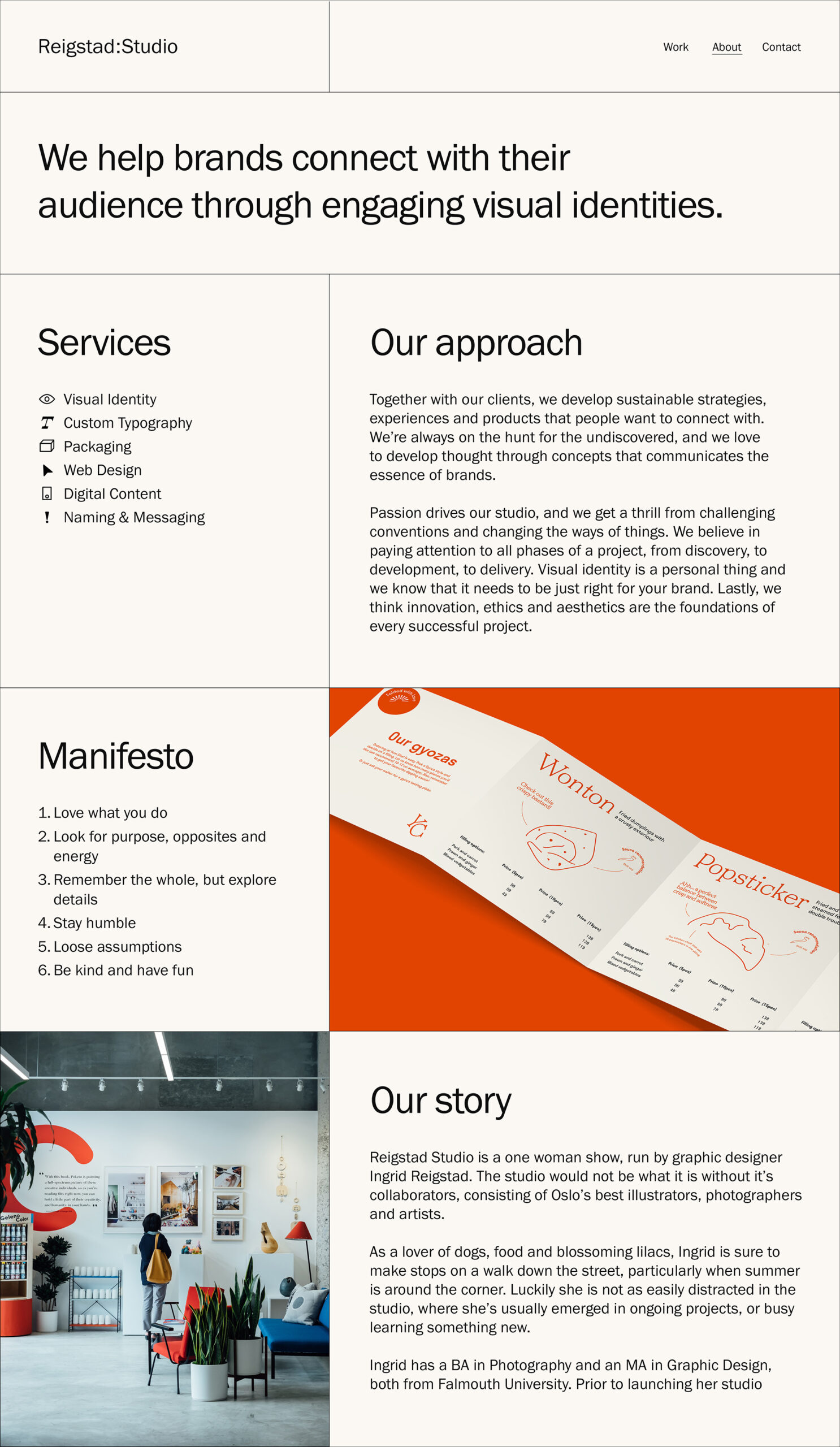
I would have loved to spend more time on the visual identity for the about page, by exploring a proper concept and a logo. However, since this was a writing task, I decided to focus on the text this week.
In conclusion
It’s been a lot of fun digging into the business side of things for the first week of this module. The provided material definitely sparked an interest in me for going freelance one day, and I look forward to learning more about entrepreneurship as we continue with the following weeks.
Detecting who I am as a designer
The workshop challenge has been surprisingly difficult, considering we “only” had to write a paragraph of text. In order to arrive at my final text I’ve had to do several rounds of reflections. This worked well as it helped me detect what I really care about and who I want to be as a designer. I do wish I would have thought about making my text personal sooner, as I think it could have become better if it had a more unique tone of voice and perhaps even more focus on who I am.
Targeting an audience
I think my text has been successful in terms of communicating elements my audience cares about, without being too obnoxious or buzz word loaded. The manifesto works well in communicating my way of working and being, and I also like the simplicity of my heading / pitch line. Working with an audience persona in mind was very helpful, and I think the text became better after catering it towards the audience and goal. As we move on with the business plan I think it could be interesting to develop my persona further, perhaps by researching business owners’ issues when developing their brands.
Room for improvement
If I had more time I would have liked to experiment with finding a specific tone of voice. I also would have liked to be more creative with my language by practicing show, not tell to a larger extent. Although the pitch is simple and to the point, it doesn’t come off as as creative and welcoming as I would have liked. All in all, it’s been very insightful to work on this week’s task and I look forward to learn more about myself as a designer as we continue with the following week.
REFERENCES:
Bleed (2018) ‘Bleed.no’, Bleed.no. Available at: https://bleed.com/ (Accessed: 31 May 2021).
Computer Arts (2016) How to Launch and Run a Design Studio. Available at: https://www.youtube.com/watch?v=m4USCXMS7BY (Accessed: 28 May 2021).
Gem Barton (2021) ‘Interview with Gem Barton’. Canvas Falmouth Flexible [online], 28 May.
Goods (2018) ‘Goods.no’, Goods. Available at: https://goods.no/ (Accessed: 30 May 2021).
Heydays (2018) ‘Heydays: approach’, Heydays. Available at: https://heydays.no/approach/ (Accessed: 31 May 2021).
Hoodzpah (2019) Graphic Design Tutorial with Hoodzpah Design (1/3). (Adobe Live). Available at: https://www.youtube.com/watch?v=8N0zmrZnL0M&ab_channel=AdobeCreativeCloud (Accessed: 30 May 2021).
OlssønBarbieri (2018) ‘OlssønBarbieri: Studio’, Olssønbarbieri.com. Available at: https://olssonbarbieri.com/studio (Accessed: 30 May 2021).
Renee Fleck (2021) ‘The graphic designer’s guide to building a stand‑out personal brand’, Dribble, 27 May. Available at: https://dribbble.com/stories/2021/05/27/personal-branding-guide-graphic-designers?utm_campaign=2021-06-02&utm_medium=email&utm_source=courtside-20210602 (Accessed: 3 June 2021).
Simon Manchipp et al. (2021) ‘Practitioner Case Studies’. Canvas Falmouth Flexible [online], 28 May.
Studio Lowrie (2016) ‘Studio Lowrie: about’, Studio Lowrie. Available at: https://studiolowrie.com/about/ (Accessed: 31 May 2021).
The Futur (2017) How To Run A Creative Business: In-depth breakdown w/ Melinda Livsey. Available at: https://www.youtube.com/watch?v=D8BN2YSyYkg (Accessed: 28 May 2021).
&Walsh (2018) ‘&Walsh: Info’, &Walsh. Available at: https://andwalsh.com/info/ (Accessed: 31 May 2021).
WolffOlins (2018) ‘WolffOlins’, WolffOlins. Available at: https://www.wolffolins.com/ (Accessed: 30 May 2021).
LIST OF FIGURES:
Figure 1: HOODZPAH. 2019. Graphic Design Tutorial with Hoodzpah Design (1/3) | Adobe Creative Cloud. . Available at : https://www.youtube.com/watch?v=8N0zmrZnL0M&ab_channel=AdobeCreativeCloud [accessed 31 May 2021].
Figure 2-4: HOODZPAH. 2019. Graphic Design Tutorial with Hoodzpah Design (1/3) | Adobe Creative Cloud. . Available at : https://www.youtube.com/watch?v=8N0zmrZnL0M&ab_channel=AdobeCreativeCloud [accessed 31 May 2021].
Figure 5. GOODS. Ca. 2019-2021. Goods Website. Goods [online]. Available at: https://goods.no/
Figure 6. OLSSØNBARBIERI. Ca. 2018-2021. OlssønBarbieri Website. OlssønBarbieri [online]. Available at: https://olssonbarbieri.com/studio
Figure 7. BLEED. 2021. Food Society. Bleed [online]. Available at: https://bleed.com/work/food-society
Figure 8. HEYDAYS. 2019. Whereby. Heydays [online]. Available at: https://heydays.no/project/whereby/
Figure 9. LOWRIE. 2020. Sundance Film Festival 2020. Lowrie [online]. Available at: https://studiolowrie.com/
Figure 10. WOLFFOLINS. 2018. Uber: Changing how the world moves. WolffOlins [online]. Available at: https://www.wolffolins.com/case-study/uber/
Figure 11. &Walsh. ca. 2016-2021. No title. [colour photograph]. &Walsh [online]. Available at: https://andwalsh.com/info/ [accessed 3 June 2021].
Figure 12. Stefan SAGMEISTER. 2018. Beauty Book. Stefan Sagmeister [online]. Available at: https://sagmeister.com/work/beauty-book/
Figure 13: Ingrid REIGSTAD. 2021. About Page. Private collection: Ingrid Reigstad.
